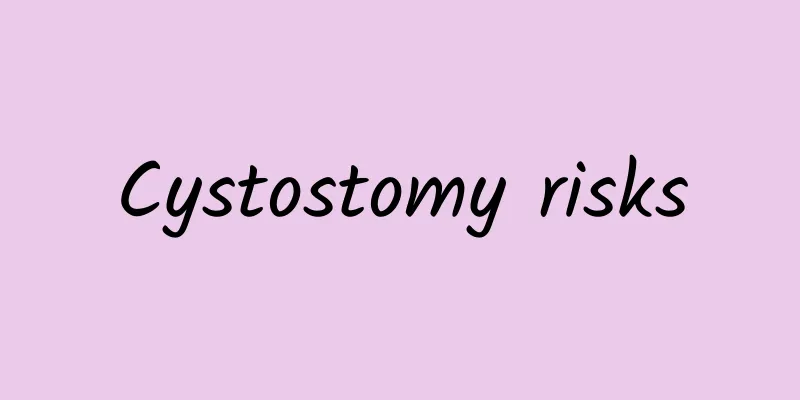Cystostomy risks

|
Cystostomy is a common surgery. After the surgery, it is important to prevent infection and avoid some surgical hazards, especially some postoperative complications. Especially for people with poor physical fitness or sensitive physical fitness, it is also very important to take care of them in daily life. They should be observed and cared for. Patients must drink plenty of water at ordinary times, which will help promote urethral flushing. Complications after cystostomy and their countermeasures 1. Bladder irrigation Bladder irrigation should be performed 1-2 days after cystostomy surgery. When the irrigation fluid turns light yellow and the cystostomy tube remains unobstructed, the indwelling catheter can be removed and bladder irrigation can be stopped. 2 Observation and care of cystostomy tube Keep the fistula tube unobstructed to avoid bending, compression and folding of the tube. Ensure that the newly formed fistula does not overflow before it heals and affect the healing of the fistula. Fix the drainage tube to prevent slippage and excessive traction. Special attention should be paid to prevent the drainage tube from shifting or falling off when the patient turns over or sleeps. During the period of tube instillation, it was found that the drainage tube was not draining smoothly and was blocked by blood clots and necrotic debris, which were removed by suction and squeezing with a syringe. You should also pay attention to the color, nature, and amount of the drainage fluid. And accurately record the amount of urine drained. 3. Water intake Instruct patients to drink plenty of water and maintain a daily water intake of 2000~2500ML to increase urine volume, dilute urine, achieve the purpose of self-flushing the urinary tract, and reduce the chance of bacteria entering the urethra. 4 Bladder function training It is not advisable to urinate continuously through a fistula tube, as continuous urination can cause disuse atrophy of the bladder detrusor muscle and eventually cause bladder spasm. Two weeks after the cystostomy, the drainage tube is generally clamped intermittently to allow urination once every 1 to 2 hours to maintain the bladder's autonomous function and prevent bladder contracture. 5. Care of the stoma skin Closely observe the condition of the stoma dressing to see if there is any bleeding or exudate. If so, the dressing should be changed immediately and the stoma dressing should be kept clean and dry. Change the dressing every other day for the first two weeks, and change it twice a week after the sinus tract is formed. Observe the stoma for secretions, redness and swelling, and for polyps around the stoma. If there is redness, swelling and excessive secretion, you can use hypertonic saline gauze to wet compress to reduce the redness and swelling, or you can apply zinc oxide. If there is blood or urine leakage, replace it immediately. 6 Postoperative inflammation of cystostomy The stimulation of foreign objects such as ostomy tubes can cause the bladder mucosa to crawl and proliferate through the ostomy opening, which can cause bleeding and odor. If this happens, use iodine tincture to disinfect it in time, and then use 2.5% to 3.5% hydrogen peroxide solution to scrub the area around the ostomy opening every 2 days. The bubbles produced can help clear the secretions from the fistula opening and kill anaerobic bacteria, and can shrink the proliferating tissue by contracting it. 7. Reduce odor After cystostomy surgery, a foul odor may occur due to long-term irritation of the tissues around the fistula due to the tube being worn. Slowly flush the bladder with 500 ml of 0.9% sodium chloride and 300,000 units of metronidazole. Metronidazole is a broad-spectrum antibiotic that can reduce odor. The flushing fluid should be kept at room temperature to prevent it from being too cold and irritating the bladder and causing convulsions in the patient's lower limbs. Using 25℃~29℃ flushing fluid to flush the bladder can effectively reduce the frequency of bladder spasms, reduce the patient's pain, and reduce the occurrence of postoperative complications. 8. Prevent retrograde infection The drainage bag must be placed below the level of the bladder to prevent urine reflux and cause retrograde bladder infection. Discard the urine in the drainage bag in time. When patients are encouraged to get out of bed and move around, they can use a pin to fix the drainage bag to their clothes, and when they go out, they can put the urine bag in a special cloth bag. In order to prevent urea precipitation from clogging the fistula tube, the balloon catheter is generally replaced once a month. The fistula tube must be of appropriate type, generally 18F to 22F, and must be replaced under sterile conditions. If there is any blockage, it should be replaced at any time. 9. Poor urine drainage or urine leakage When this happens, pay attention to whether the fistula tube is blocked and then adjust the position of the fistula tube. When urine leakage is severe, a negative pressure suction tube should be inserted. |
<<: Precautions after cystectomy
>>: How to Massage the Bladder Meridian
Recommend
How to recover from astigmatism
Eye astigmatism is a very common condition in dai...
Symptoms of wound inflammation after normal delivery
Many female friends experience symptoms of wound ...
Holding back semen
Many male friends encounter this situation when h...
The reasons for moles on the philtrum and their meanings
The mole on the philtrum is actually something th...
The correct way to eat deer penis paste
Deer penis paste is a Chinese patent medicine tha...
What causes dull ear pain?
If you feel a dull pain in your ears, you should ...
How to relieve synovitis pain
Synovitis is a very common joint disease. If a pe...
Do you know the best treatment for mastitis?
In real life, mastitis is a common disease among ...
The causes of fat particles on the face
It is quite common to have fat particles on the f...
What are the ingredients of isinglass? What are the benefits of fish maw?
Maybe many friends still don’t know what is ising...
Dialysis puncture needle
Dialysis is a separation and purification techniq...
Under what circumstances do patients with aplastic anemia need blood transfusion? What should they pay attention to?
In some cases, patients with aplastic anemia have...
What are the symptoms of impotence
Impotence is a common sexual dysfunction in men. ...
What to do if you have acne on your upper lip? Ten daily care methods
The lips are one of the thinnest parts of the hum...
What causes frequent urination, urgency and urinary incontinence?
Many people neglect their physical health in thei...









